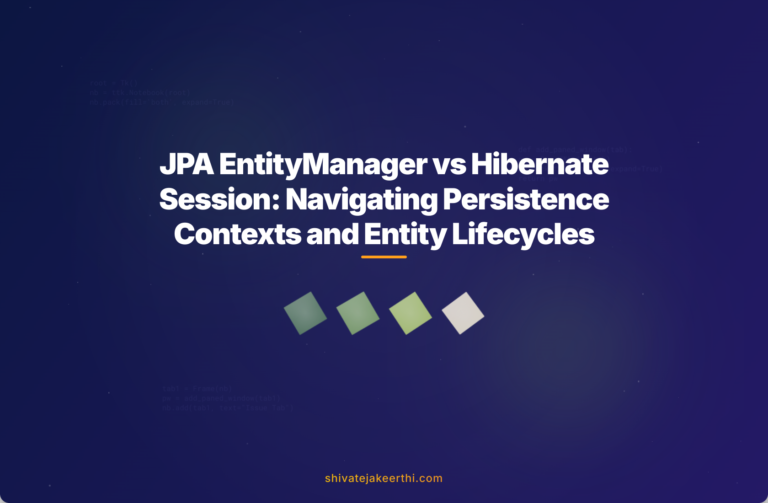When working with Java persistence, two important interfaces often come to mind—JPA EntityManager and Hibernate Session. Developers frequently ask how these two differ, and how they’re related to something known as the “Persistence Context.” Understanding these concepts is key to efficiently managing your database interactions and avoiding common pitfalls.
Understanding the Persistence Context
The Persistence Context is a fundamental concept that represents a collection of managed entity instances within a session. It’s your application’s “first-level cache,” a short-lived container where entities are tracked and synchronized with the database.
Think of Persistence Context as your shopping cart in an online shop. You add items, modify them, or remove them before making a final payment (committing your transaction). Once you buy, all the changes you’ve made in your cart reflect in the store’s database—this is essentially how changes flow from your context into the database.
Persistence Context in Hibernate Session
In Hibernate, a Session directly manages your entities. When you invoke session methods like save(), update(), delete(), or queries, Hibernate adds those entities into the session’s persistence context.
Here’s a quick example using Hibernate:
Session session = sessionFactory.openSession();
Transaction tx = session.beginTransaction();
Employee emp = session.get(Employee.class, 1);
emp.setName("John Doe"); // automatically tracked by session
tx.commit(); // Database updates happen here
session.close();
Notice how Hibernate automatically detects changes to the managed entity and synchronizes these changes to the database when you commit the transaction.
Persistence Context in JPA EntityManager
JPA’s EntityManager works similarly but offers a standardized way across different persistence providers (like Hibernate or EclipseLink). An EntityManager’s persistence context also tracks the persistence state automatically.
Here’s how you’d achieve the same function using JPA’s EntityManager:
EntityManager em = entityManagerFactory.createEntityManager();
EntityTransaction tx = em.getTransaction();
tx.begin();
Employee emp = em.find(Employee.class, 1);
emp.setName("John Doe"); // changes tracked automatically
tx.commit(); // Flushes changes to DB
em.close();
Key Differences Between EntityManager and Session
While these two seem to perform very similar tasks, some subtle differences help them cater to slightly different audiences:
- Storage of Managed Entities: Both EntityManager and Hibernate Session store entities inside the same persistence context, but EntityManager is an interface provided by the Java EE standard, while Session is a specific Hibernate interface.
- Direct Interaction: Hibernate Session has a larger set of proprietary methods and advanced query capabilities. EntityManager, meanwhile, provides a subset of those operations standardized across multiple providers.
- Need for EntityManager in JPA: EntityManager makes your code portable across different ORM frameworks. Hibernate, EclipseLink, and OpenJPA all support EntityManager, which is beneficial for applications requiring easy portability.
What Exactly Does Hibernate Session Offer?
The Hibernate Session interface comes directly from Hibernate, giving you extensive functionalities to interact with the database. Here’s what it mainly provides:
- Managing Entities: Hibernate Session queries entities and tracks their state.
- Rich API: Methods such as
save(),update(),merge(), and criteria-based query support. - SessionFactory Interface: Creating a Hibernate session demands a properly initialized SessionFactory object:
Example Initialization of a SessionFactory:
SessionFactory sessionFactory = new Configuration()
.configure("hibernate.cfg.xml")
.addAnnotatedClass(Employee.class)
.buildSessionFactory();
You can get sessions from that SessionFactory for each database interaction.
JPA EntityManager: What Does it Do Differently?
An EntityManager performs similar actions but is standardized across JPA implementations and isn’t tied to Hibernate alone.
Key differences include:
- Standardized Interface: JPA standard provides EntityManager to abstract from underlying ORM providers (like Hibernate).
- Simplified Setup: EntityManager doesn’t need Session-specific configurations; it uses Persistence Units defined in
persistence.xml. - Transaction Management: EntityManager uses EntityTransaction API instead of Hibernate Transaction.
Using EntityManager, you’d typically use a persistence unit configured as follows:
EntityManagerFactory emf = Persistence.createEntityManagerFactory("MyPersistenceUnit");
EntityManager em = emf.createEntityManager();
Interaction with Persistence Context: EntityManager in Action
The JPA EntityManager seamlessly interacts with the Persistence Context. Actions executed through methods like persist(), remove(), merge(), and find() involve adding or updating entities directly within this context.
EntityManager brings abstraction and ease. For instance, to persist an entity:
em.getTransaction().begin();
Employee emp = new Employee();
emp.setName("Alice");
em.persist(emp); // EntityManager tracks this entity
em.getTransaction().commit();
The key advantages EntityManager offers:
- Portability between different JPA providers
- Cleaner, standardized coding conventions
- Less dependency on specific ORM methods and features
Read more about JPA standard to understand its benefits further.
Clearing Up Common Misconceptions
Developers often mistakenly think that EntityManager and Hibernate Session are completely interchangeable entities. Not entirely true; JPA EntityManager is an interface that abstracts your database interactions and makes your code portable across providers, while a Hibernate Session is specifically designed for Hibernate.
It’s essential to clearly understand the role of EntityManager within Java EE applications. EntityManager deals directly with the Persistence Context through a set of standardized methods, leaving actual data store interactions to the persistence provider.
Comparing EntityManager and Hibernate Session Side-by-Side
| Feature | Hibernate Session | JPA EntityManager |
| Creation | SessionFactory | EntityManagerFactory |
| Standardized | No (Hibernate specific) | Yes (Part of JPA specification) |
| Query API | Advanced and extensive (Criteria API) | Standardized, but slightly limited |
| Portability | Limited; closely tied to Hibernate | Easily portable across JPA implementations |
Understanding these differences helps decide which approach works better for your project scenario.
To further explore object-relational setups, check out this guide on JavaScript functionalities for your front end to complement optimized backend implementations.
Understanding the subtle differences in functionality and how EntityManager and Hibernate Session interact with Persistence Context gives you clarity. This understanding allows for better decisions in project setups, making your JPA implementations smoother, faster, and less error-prone.
Did these insights help clarify your concepts around EntityManager and Hibernate Session? Share your thoughts or questions below!



0 Comments